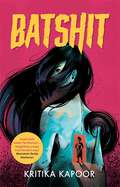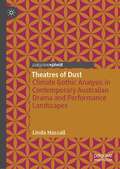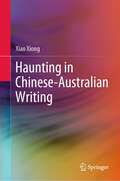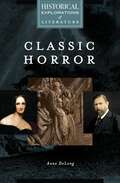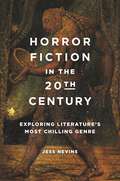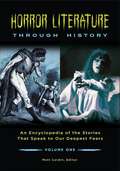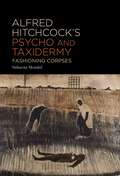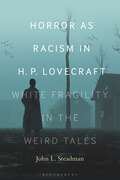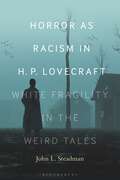- Table View
- List View
Batshit
by Kritika KapoorTwenty-something Pia Bhandari has the ideal life – or so it seems. As long as she puts on a happy face, no one is any the wiser about the sinister voices in her head. Not her boyfriend Raghav, or her soon-to-be-married younger sister Khushi, her long-time psychiatrist Dr Agarwal, her father Ajit or even her mother Neeta, who is otherwise obsessed with controlling her daughter’s life.But Pia’s demons follow her wherever she goes. One yellow-eyed demon in particular. Feral and bloodthirsty, it threatens to rip through Pia’s life, leaving a murderous trail in its wake. Hurtling between the opulent kothis of GK-2 to the plush bungalows of Sainik Farms, this twisted tale about a Delhi girl’s fight against the dark forces is about to get batshit.
Theatres of Dust: Climate Gothic Analysis in Contemporary Australian Drama and Performance Landscapes
by Linda HassallThrough a contemporary Gothic lens, the book explores theatre theories, processes and practices that explore; the impacts of continuing drought and natural disaster, the conflicts concerning resource extraction and mining and current political debates focussed on climate change denial. While these issues can be argued from various political and economic platforms, theatrical investigations as discussed here suggest that scholars and theatre makers are becoming empowered to dramaturgically explore the ecological challenges we face now and may face in the future. In doing so the book proposes that theatre can engage in not only climate change analysis and discussion but can develop climate literacies in a broader socio-cultural context.
Haunting in Chinese-Australian Writing
by Xiao XiongThis book examines haunting in terms of trauma, languaging, and the supernatural in works by Chinese Australian writers born in Australia, Mainland China, Hong Kong, Malaysia, and Singapore. It goes beyond the conventional focus on identity issues in the analysis of diasporic writing, considering how the memory of past trauma is triggered by abusive systems of power in the present. The author unpacks how trauma also brings past violence to haunt the present. This book considers how different Chinese diasporic communities present a dynamic and multiple state through partial erasure between different Chinese subcultures and other cultures.Showing the supernatural as a social and cultural product, this book elucidates how haunting as the supernatural refers to the coexistence of, and the competition between, different cultures and powers. It takes a wide-ranging view of different diasporic communities under the banner ‘Chinese’, a term that refers not only to Chinese nationals in terms of citizenship, but also to the Chinese diaspora in terms of ancestry, and Chinese culture more generally. In analysing haunting in texts, the author positions Chinese culture as in a constant state of flux. It is relevant to literary scholars and students with interests in Australian literature, Chinese and Southeast Asian migration writing, and those with an interest in the Gothic and postcolonial traditions.
Classic Horror: A Historical Exploration of Literature (Historical Explorations of Literature)
by Anne DeLongA valuable resource for readers exploring the classic horror genre, this book presents primary source documents alongside analysis in an examination of the social, political, and economic factors reflected in 19th century Gothic literature.The nineteenth century was a time of social, cultural, and economic change; revolutionary scientific developments; and enduring imaginative works. This book explores the classic horror genre of Gothic literature in its historical and social contexts. It contains chapters on four major works of classic horror, with each chapter providing a mix of background information, primary source historical documents, and analysis that will appeal as much to high school and college students as to lovers of literature and the Victorian era.Coleridge's The Rime of the Ancient Mariner is contextualized through documents pertaining to British imperialism, Antarctic Exploration, and the burgeoning environmentalist movement. Shelley's Frankenstein is explored through sections on galvanism, electricity, grave robbing, and the vitalist debate. Stevenson's The Strange Case of Dr. Jekyll and Mr. Hyde is read through explanations of nineteenth-century drug use and addiction and early theories of psychology and criminology. Stoker's Dracula is studied with reference to such topics as mesmerism, clairvoyance, alienism, medical ethics, xenophobia, and Victorian pseudoscience.
Horror Fiction in the 20th Century: Exploring Literature's Most Chilling Genre
by Jess NevinsProviding an indispensable resource for academics as well as readers interested in the evolution of horror fiction in the 20th century, this book provides a readable yet critical guide to global horror fiction and authors.Horror Fiction in the 20th Century encompasses the world of 20th-century horror literature and explores it in a critical but balanced fashion. Readers will be exposed to the world of horror literature, a truly global phenomenon during the 20th century. Beginning with the modern genre's roots in the 19th century, the book proceeds to cover 20th-century horror literature in all of its manifestations, whether in comics, pulps, paperbacks, hardcover novels, or mainstream magazines, and from every country that produced it. The major horror authors of the century receive their due, but the works of many authors who are less well-known or who have been forgotten are also described and analyzed. In addition to providing critical assessments and judgments of individual authors and works, the book describes the evolution of the genre and the major movements within it. Horror Fiction in the 20th Century stands out from its competitors and will be of interest to its readers because of its informed critical analysis, its unprecedented coverage of female authors and writers of color, and its concise historical overview.
Horror Literature through History [2 volumes]: An Encyclopedia of the Stories That Speak to Our Deepest Fears [2 volumes]
by Editor Matt CardinThis two-volume set offers comprehensive coverage of horror literature that spans its deep history, dominant themes, significant works, and major authors, such as Stephen King, Edgar Allan Poe, and Anne Rice, as well as lesser-known horror writers.Many of today's horror story fans—who appreciate horror through movies, television, video games, graphic novels, and other forms—probably don't realize that horror literature is not only one of the most popular types of literature but one of the oldest. People have always been mesmerized by stories that speak to their deepest fears. Horror Literature through History shows 21st-century horror fans the literary sources of their favorite entertainment and the rich intrinsic value of horror literature in its own right. Through profiles of major authors, critical analyses of important works, and overview essays focused on horror during particular periods as well as on related issues such as religion, apocalypticism, social criticism, and gender, readers will discover the fascinating early roots and evolution of horror writings as well as the reciprocal influence of horror literature and horror cinema.This unique two-volume reference set provides wide coverage that is current and compelling to modern readers—who are of course also eager consumers of entertainment. In the first section, overview essays on horror during different historical periods situate works of horror literature within the social, cultural, historical, and intellectual currents of their respective eras, creating a seamless narrative of the genre's evolution from ancient times to the present. The second section demonstrates how otherwise unrelated works of horror have influenced each other, how horror subgenres have evolved, and how a broad range of topics within horror—such as ghosts, vampires, religion, and gender roles—have been handled across time. The set also provides alphabetically arranged reference entries on authors, works, and specialized topics that enable readers to zero in on information and concepts presented in the other sections.
Alfred Hitchcock’s Psycho and Taxidermy: Fashioning Corpses
by Subarna MondalThere are numerous scholarly works on Alfred Hitchcock's Psycho (1960). Some of these works have explored its Gothic potentials. However, no detailed effort has yet been made to explore one of its major motifs – taxidermy. Taxidermy as an art of corporeal preservation has effectively been used in mainstream body horror films years after Psycho was released. Yet Psycho was one of the first films to explore its potentials in the Gothic genre at a time when it was relegated to a low form of art. Alfred Hitchcock's Psycho and Taxidermy focuses on taxidermy as a cultural practice in both Victorian and modern times and how it has been employed both metaphorically and literally in Hitchcock's films, especially Psycho. It also situates Psycho as a crucial film in the filmic continuum of body horrors where death and docility share a troubled relationship.
Alfred Hitchcock’s Psycho and Taxidermy: Fashioning Corpses
by Subarna MondalThere are numerous scholarly works on Alfred Hitchcock's Psycho (1960). Some of these works have explored its Gothic potentials. However, no detailed effort has yet been made to explore one of its major motifs – taxidermy. Taxidermy as an art of corporeal preservation has effectively been used in mainstream body horror films years after Psycho was released. Yet Psycho was one of the first films to explore its potentials in the Gothic genre at a time when it was relegated to a low form of art. Alfred Hitchcock's Psycho and Taxidermy focuses on taxidermy as a cultural practice in both Victorian and modern times and how it has been employed both metaphorically and literally in Hitchcock's films, especially Psycho. It also situates Psycho as a crucial film in the filmic continuum of body horrors where death and docility share a troubled relationship.
Horror as Racism in H. P. Lovecraft: White Fragility in the Weird Tales
by Dr. or Prof. John L. SteadmanProviding a new perspective on Lovecraft's life and work, Horror as Racism in H.P. Lovecraft focuses on the overlap between the writer's personal beliefs and the racist images and narratives in his speculative fiction. Building on recent debates about Lovecraft and drawing on the concept of "white fragility," John Steadman argues that the writer's fiction reflects his feelings of resentment and anger towards non-white persons and was used to advocate for his racist, xenophobic political beliefs – that western civilization was in decline and slavery was justifiable among "superior" civilizations. In making these claims, Lovecraft's tales pit humans against extra-terrestrial aliens, developing a terrifying, futuristic vision of the Earth as a plantation planet. The familiar image of Lovecraft as a reclusive, creative genius and mentor to young writer-friends is dismantled through close readings of his fiction and nonfiction – including correspondence, essays, and poetry – and examination of his early biography. This image is replaced by that of a cruel, callous, and, at times, psychotic man, a violently vitriolic racist and white supremacist who hated most of the non-white races. While some will dismiss the author outright and others will read his fiction but ignore the racism, Horror as Racism in H.P. Lovecraft takes a middle ground: acknowledging Lovecraft's personal history and heinous intentions, it helps readers navigate the author's disturbing biography while also getting a better sense of the stories, which remain significant within American science fiction.
Horror as Racism in H. P. Lovecraft: White Fragility in the Weird Tales
by Dr. or Prof. John L. SteadmanProviding a new perspective on Lovecraft's life and work, Horror as Racism in H.P. Lovecraft focuses on the overlap between the writer's personal beliefs and the racist images and narratives in his speculative fiction. Building on recent debates about Lovecraft and drawing on the concept of "white fragility," John Steadman argues that the writer's fiction reflects his feelings of resentment and anger towards non-white persons and was used to advocate for his racist, xenophobic political beliefs – that western civilization was in decline and slavery was justifiable among "superior" civilizations. In making these claims, Lovecraft's tales pit humans against extra-terrestrial aliens, developing a terrifying, futuristic vision of the Earth as a plantation planet. The familiar image of Lovecraft as a reclusive, creative genius and mentor to young writer-friends is dismantled through close readings of his fiction and nonfiction – including correspondence, essays, and poetry – and examination of his early biography. This image is replaced by that of a cruel, callous, and, at times, psychotic man, a violently vitriolic racist and white supremacist who hated most of the non-white races. While some will dismiss the author outright and others will read his fiction but ignore the racism, Horror as Racism in H.P. Lovecraft takes a middle ground: acknowledging Lovecraft's personal history and heinous intentions, it helps readers navigate the author's disturbing biography while also getting a better sense of the stories, which remain significant within American science fiction.
